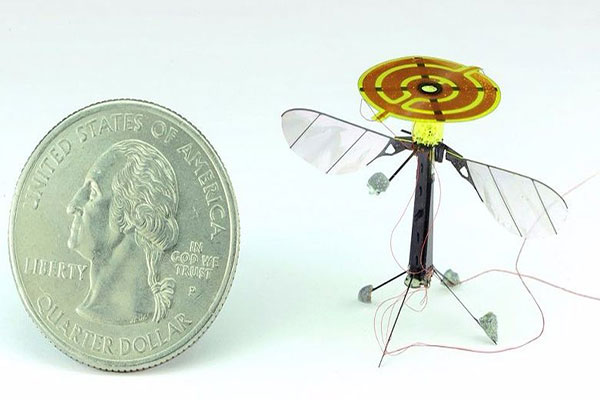Harvard Researchers Developing Bee Drone That Uses Insect Tactics To Conserve Battery Life
Soon the expression “I wish I could have been a fly on the wall” will be more than just an idiom. A team of Harvard scientists is building a bee-inspired micro aerial vehicle (MAV) robot. The robot is intended for “basically any situation where you want to have low cost and distributed sensing [that] would be too difficult or too dangerous for a human."
 Why is the MAV modeled after an insect? For most drones, hovering consumes as much energy as flying. As long as the drone is in the air, it eats up its small battery. Scientists discovered that they could save a considerable amount of energy if the drone rested in between flights like insects do.
Why is the MAV modeled after an insect? For most drones, hovering consumes as much energy as flying. As long as the drone is in the air, it eats up its small battery. Scientists discovered that they could save a considerable amount of energy if the drone rested in between flights like insects do.
The MAV has a electrostatic patch that consists of a carbon fiber base, copper electrodes and a polyamide coating. The patch sits on a small foam cylinder. The electrostatic plate can attach itself to any surface which produces static electricity such as wood and glass. The foam cylinder helps to cushion the landing and prevent the robot from bouncing off surfaces.
The robot perches in a similar manner to a bee. It slow down until it’s hovering right underneath the landing spot and then slowly rises up until it is touching the surface. The electrostatic patch powers up and creates a bond strong enough to hold the robot in place. The robot can remain perched for as long as the patch is powered up. The adhesion can be turned on and off without the need for moving parts.The robot-bee can also land, perch and take off without applying any force to the landing surface.

The use of static electricity does place weight constraints on the robot. The amount of weight the patch can support is proportional to the area of the patch. Co-author of the study Robert Wood stated, “But as size is reduced, surface area (thus adhesion) increases faster than volume (thus weight). What this means is that this sort of adhesive mechanism is quite appropriate for small-scale systems."
The project is still working to remove the tether wires and integrate power and flight control-technology. These developments could take another 5 to 10 years. At the moment, the research has just “bee-gun”.

The MAV has a electrostatic patch that consists of a carbon fiber base, copper electrodes and a polyamide coating. The patch sits on a small foam cylinder. The electrostatic plate can attach itself to any surface which produces static electricity such as wood and glass. The foam cylinder helps to cushion the landing and prevent the robot from bouncing off surfaces.
The robot perches in a similar manner to a bee. It slow down until it’s hovering right underneath the landing spot and then slowly rises up until it is touching the surface. The electrostatic patch powers up and creates a bond strong enough to hold the robot in place. The robot can remain perched for as long as the patch is powered up. The adhesion can be turned on and off without the need for moving parts.The robot-bee can also land, perch and take off without applying any force to the landing surface.

Credit: American Association For The Advancement of Science
The use of static electricity does place weight constraints on the robot. The amount of weight the patch can support is proportional to the area of the patch. Co-author of the study Robert Wood stated, “But as size is reduced, surface area (thus adhesion) increases faster than volume (thus weight). What this means is that this sort of adhesive mechanism is quite appropriate for small-scale systems."
The project is still working to remove the tether wires and integrate power and flight control-technology. These developments could take another 5 to 10 years. At the moment, the research has just “bee-gun”.

